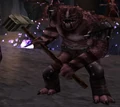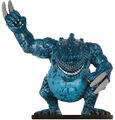Physical description
Slaadi are elemental humanoids native to the Supreme Throne[1] (formerly Limbo[2]). Their base form is that of a large bipedal frog, though some of the more powerful slaadi have polymorph self or shape change abilities and sometimes appear as men. In frog form their heads are huge and their claws are extremely sharp. They speak their own language and, occasionally, some additional evil languages. Telepathy however allows them to understand and converse with all things. There are many types of slaadi depending on their place of origin and rank within their society. The most common types of slaadi are blue slaadi, green slaadi, red slaadi, gray slaadi (the executioners) and death slaadi (the lesser masters). Some are even chalk-white slaadi like Chourst, and very rarely do they turn into black slaadi. Size also varies between the different subtypes, from human sized to several feet taller than human sized. Most Slaad are almost always chaotic neutral, with the exception of death slaadi, which are usually chaotic evil, and the gormeel slaadi, which are usually lawful neutral. All slaadi, being outsiders composed of the essence of Limbo itself, have natural darkvision of up to 60 feet.
Society
Slaadi have been depicted as having a complex social system bound up in the relationship and reproductive cycles of the various types. Some types will naturally dominate others, though as slaadi are creatures of chaos, such domination occurs not through a regimented hierarchy, but by brute force. In earlier times a symbol of power was embedded in each slaad's forehead, and non-magical tattoos on the forehead represented achievements and status.[3] These markings do not appear commonly as they once did, and most of the time the hierarchy is based solely on whoever is the stronger. For a long time it was believed that the aforementioned types of slaad have been the only ones in existence, but in recent years the Mud slaad, and the superior White, and Black slaad have also been discovered. It has also been determined that the slaadi race is ruled by two Slaad Lords known as Ssendam and Ygorl.
Reproduction
Red and blue slaadi reproduce by infecting living hosts. The red do so by implanting eggs beneath their victim's skin which grow into a baby blue slaad that eats the host from within. The blue infect the host with a lycanthropy-like disease that slowly transforms them into a red slaad. All those infected with this disease become female, regardless of previous gender. Whether the transformation is mental is unknown. Despite being the means of producing the other slaad type, reds and blues despise one another. If either a red slaad or blue slaad infects an arcane spellcaster, the host will spawn a green slaad, superior to its parent in that it may cast spells. A green slaad, upon reaching its hundredth year of life, will retreat into isolation for the duration of about a year. Upon its return it has transformed into a smaller, but more powerful grey slaad, which focus more on spell-casting than most of the other slaadi. Some grey slaadi may undergo an unnamed, mysterious ritual, which transforms them into death slaadi. Death slaadi possess amazing magical and physical might, but eschew focusing on the former, as the greys do, being bent more on perpetuating slaughter and death. As such, death slaad tend to lean towards an evil alignment than do most other slaadi. If the death slaad survives a century, it turns into the white slaad.[4] And if the white slaad survives a century, it turns into a black slaad in the manner of its preceding transformations. The black slaad is the most powerful slaad, excluding the slaad lords themselves.[5][6]
The Spawning Stone is the primordial home of the slaadi, located in "a realm of their greatest dominion" which drifts about Limbo. The passage of the stone generates currents in the raw chaos-stuff of the plane, and slaadi are able to follow these currents "upstream" to the Stone's location. In the mating season, each race of slaad converges on the Spawning Stone, wresting the Stone away from the previous group, so that they may fertilize each others' internal egg sacs, and carry away the seed-like fertilized eggs for later implantation into host bodies. Sometimes, however, young slaadi are produced right there at the stone because the slaadi implant each other in their mating frenzy. Thus, dead adult slaadi routinely float about the stone until destroyed by the chaos of Limbo. True slaadi are described as beings of ultimate chaos who have no set form. Only the Slaad Lords Ssendam and Ygorl are representative of this type. Somehow they affected the 'Spawning Stone' to prevent the emergence of slaadi more powerful than them, which keeps the slaadi within the aforementioned groups. Although anomalies do slip through in the chaos, they have less variety, and less chance of being more powerful than the Slaad Lords.[7] One such anomaly is the Gormeel Slaad[8], which is a large, mutant variety "born from the Spawning Stone", provided that they are lucky enough to escape the notice of Ygorl and Ssendam. They are lawful in alignment, serving as allies and sometimes mounts of the githzerai against other slaadi.
Slaad Lords
Slaad Lords are the de facto rulers of the slaad race. Though true to their chaotic nature they often do not appear anything like other Slaadi.
Notable slaad lords
- Chourst, Lord of Randomness[9]
- Rennbuu, Lord of Colors[10]
- Ssendam, Lord of Madness[11]
- Wartle[12]
- Ygorl, Lord of Entropy[13]
Gallery
References
- ↑ Richard Baker, James Wyatt (March 2004). Player's Guide to Faerûn. (Wizards of the Coast), p. 163. ISBN 0-7869-3134-5.
- ↑ Brian R. James, Ed Greenwood (September 2007). The Grand History of the Realms. Edited by Kim Mohan, Penny Williams. (Wizards of the Coast), p. 5. ISBN 978-0-7869-4731-7.
- ↑ Allen Varney (1998). Planescape Monstrous Compendium Appendix. (TSR, Inc), pp. 88–91.
- ↑ Andy Collins (2002). Epic Level Handbook. (Wizards of the Coast), p. 218.
- ↑ Andy Collins (2002). Epic Level Handbook. (Wizards of the Coast), p. 219.
- ↑ Eric Cagle (2003). Fiend Folio. (Wizards of the Coast), p. 157.
- ↑ Jeff Grubb (2001). Manual of the Planes. (Wizards of the Coast), p. 96.
- ↑ Chris Thomasson (2003). Killing Cousins: Githzerai Hit Squads. (Paizo Publishing, LLC), p. 52–58.
- ↑ Edward Bonny (September 1995). “The Dragon's Bestiary: Lords of Chaos”. In Wolfgang Baur ed. Dragon #221 (TSR, Inc.), pp. 76–77.
- ↑ Edward Bonny (September 1995). “The Dragon's Bestiary: Lords of Chaos”. In Wolfgang Baur ed. Dragon #221 (TSR, Inc.), pp. 77–78.
- ↑ Edward Bonny (September 1995). “The Dragon's Bestiary: Lords of Chaos”. In Wolfgang Baur ed. Dragon #221 (TSR, Inc.), pp. 72–75.
- ↑ Gary L. Thomas ed. (May 1988). Tales of the Outer Planes. (TSR, Inc.), p. 55. ISBN 978-0880385442.
- ↑ Edward Bonny (September 1995). “The Dragon's Bestiary: Lords of Chaos”. In Wolfgang Baur ed. Dragon #221 (TSR, Inc.), pp. 75–76.












